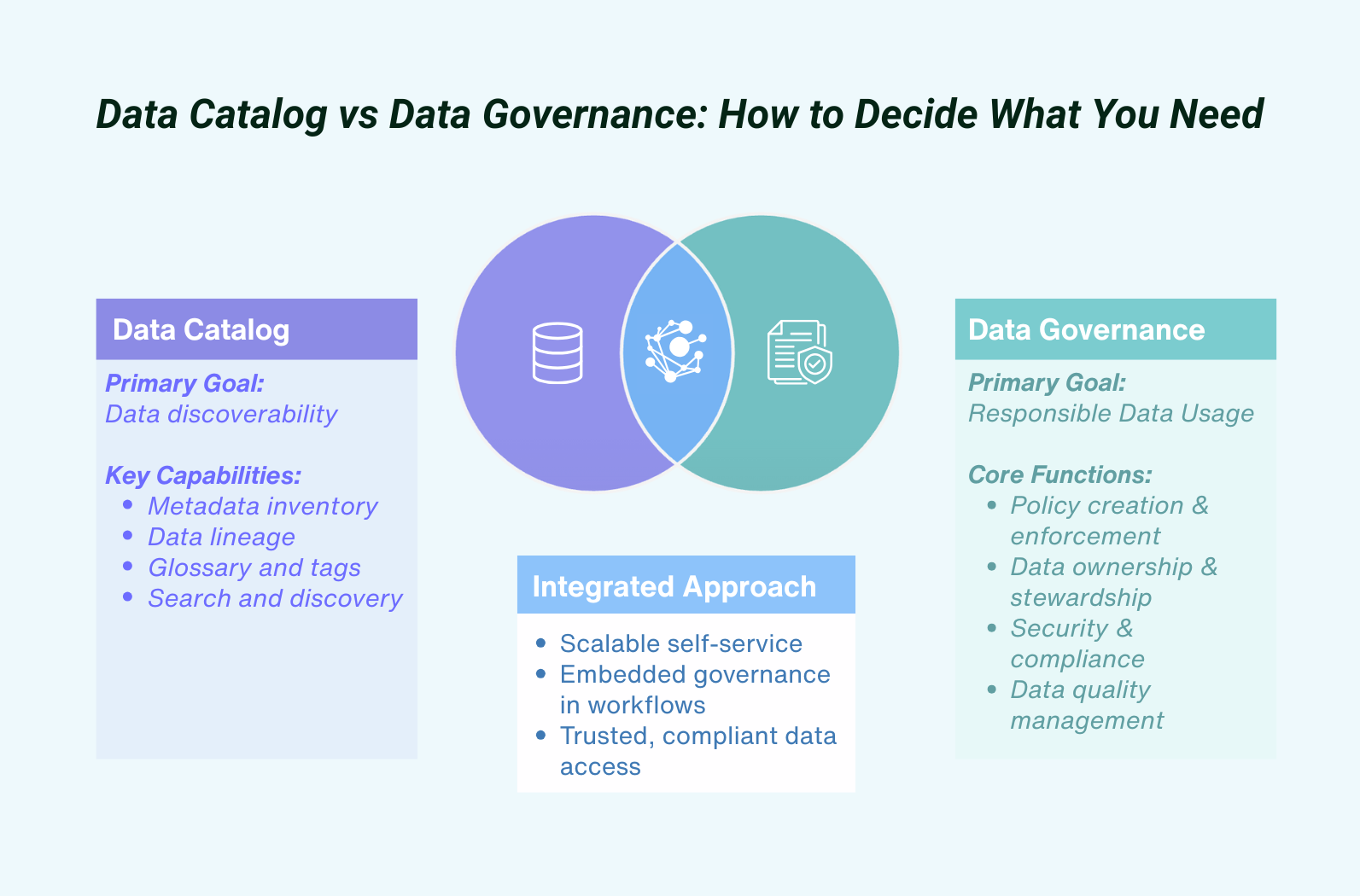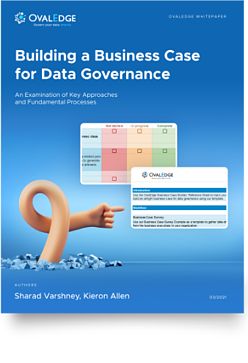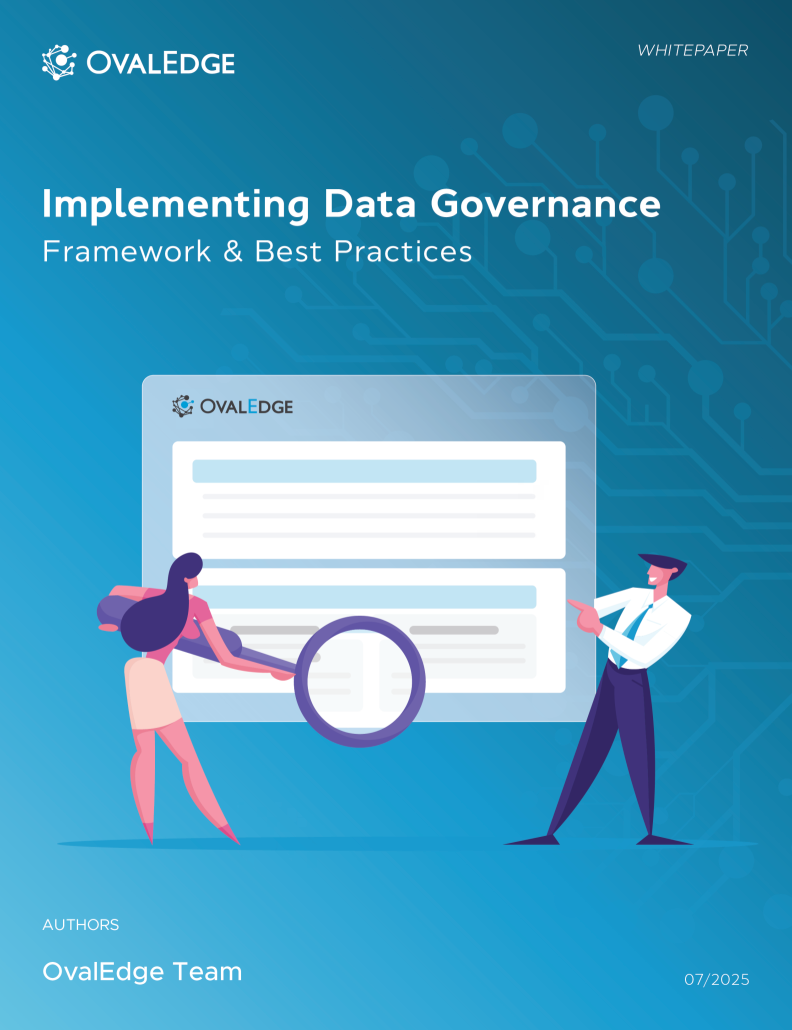Table of Contents

Data Catalog vs Data Governance Compared for Teams
Data catalogs and data governance programs are two distinct yet interconnected pillars of modern data management. While a data catalog enhances discoverability by providing a centralized, searchable view of data assets, data governance establishes the policies, roles, processes, and controls needed to ensure data is high quality, secure, compliant, and used responsibly. This blog breaks down their unique roles, explores what a data catalog is used for, and shows why mature organizations ultimately need both to scale data access without sacrificing trust or control.
What is a data catalog?
A data catalog definition centers on a searchable repository of metadata that inventories databases, tables, reports, and dashboards, enabling discovery, understanding, and trust in data assets.
Modern catalogs incorporate AI-driven automation for tagging, lineage previews, and collaboration, with 70% of enterprises adopting active metadata by 2026 per Gartner - boosting discovery speed by 40%. Unlike static lists, they integrate with BI tools and governance platforms for self-service analytics. Explore OvalEdge for automated cataloging that scales across clouds and on-prem sources.
Data catalogs organize and make data discoverable, but without governance, they risk exposing sensitive information or low-quality assets.
Data governance provides the rules, roles, and processes to ensure data is accurate, secure, and compliant throughout its lifecycle.
Together, they form a powerful duo: catalogs for accessibility, governance for trustworthiness.
What is data governance?
Before exploring data governance tools, it’s important to understand the data governance definition. Data governance is a strategic program that ensures data across the organization is accurate, secure, and used responsibly. It’s not a single tool or dashboard it’s a framework combining policies, roles, processes, and controls to manage data as a critical business asset.
Core functions:
-
Policy Creation & Enforcement: Establishes who can access and modify data, and monitors adherence to these policies.
-
Data Ownership & Stewardship: Assigns responsibility for datasets, ensuring accountability.
-
Security & Compliance: Ensures sensitive data is managed in accordance with internal and external regulations like GDPR and HIPAA.
-
Data Quality Lifecycle Management: Implements controls to prevent errors and ensure good data decisions.
Effective governance isn’t just documentation, it must be operationalized. This is why organizations use data governance tools alongside data catalog tools. When integrated, governance policies show up directly where users interact with data, creating a seamless experience. Governance then becomes a living process reinforced by technology, scaled by workflows, and sustained by organizational commitment.
Data catalog vs. data governance: How to choose based on your current data challenges
Not every organization needs both from day one. Your decision should start with a clear understanding of the problem you’re trying to solve, whether that’s making data more discoverable, managing it responsibly, or handling growing complexity. Here's how to choose the right starting point based on your current challenge.
1. When discoverability is the main challenge, use a data catalog
If your primary issue is that teams can't find or access the data they need quickly, a data catalog is the right starting point. It centralizes metadata, making datasets searchable, understandable, and easier to use across the organization.
-
Example: A marketing team searching for customer segmentation data has to ask multiple departments or spend hours combing through different systems. This leads to delays and inefficiencies. A data catalog centralizes metadata, enabling quick and easy search.
2. When responsible data usage is the goal, start with data governance
Once data becomes accessible, it must be handled securely and with accountability. This is where data governance tools play a vital role.
In early stages, governance can be implemented without a data catalog using tools like Excel or SharePoint, to manage:
-
Roles and responsibilities
-
Data ownership and access rights
-
Basic quality checks and approval workflows
This lightweight approach works initially, but as data environments grow, data catalog tools help operationalize governance across systems and teams.
-
Example: A healthcare organization needs to manage patient data with strict confidentiality. Data governance ensures only authorized personnel have access, reducing the risk of breaches and supporting HIPAA compliance.
3. When the data landscape is complex, you need both
In large enterprises or rapidly growing organizations, both data catalog and data governance programs become essential. A catalog addresses discoverability, while governance ensures security, quality, and compliance.
-
Example: An e-commerce company operating across multiple regions and product lines has ever-growing datasets. A catalog helps teams access relevant sales and customer data, while governance ensures that reporting data is clean, policy-compliant, and appropriately accessed based on roles.
At this stage, the data catalog becomes an integral part of the data governance framework, helping enforce policies while improving trust and discoverability across the organization.
Simply, The Difference Between Data Catalogs and Data Governance
A data catalog is a centralized inventory of data assets, while data governance establishes overarching policies for data quality, security, and compliance. This blog clarifies their distinct roles, synergies, and why both are essential for modern data strategies, drawing from industry best practices and 2026 trends.
Data Governance vs Data Management
Data governance vs data management distinguishes strategic oversight from operational execution: governance defines policies, roles, and compliance rules (e.g., GDPR enforcement), while management handles ingestion, storage, transformation, and quality checks.
Governance sets the "what" and "why"; management delivers the "how," with 65% of firms integrating both for 30% better data ROI per surveys. Without governance, management leads to siloed chaos; pair them via tools like OvalEdge for unified workflows.
Why Integrate Data Catalogs with Governance?
-
Enhanced Trust: Catalogs tag governed data with quality scores and lineage.
-
Compliance Automation: Governance rules auto-enforce access in catalogs.
-
Scalability: Handles big data volumes with federated search.
In 2026, integration reduces data incidents by 35%, per industry benchmarks.
Data Lineage vs Data Catalog
Data lineage vs data catalog clarifies complementary tools: a data catalog inventories and describes assets via metadata for discovery, while lineage traces data flow, transformations, and origins across pipelines (table/column-level).
Catalogs provide the "what"; lineage the "how it got here," enabling root-cause analysis—e.g., tracing a BI report error to an ETL change in seconds. Together, they cut debugging time by 50%; automate both with OvalEdge for end-to-end visibility in hybrid environments.
OvalEdge: Unifying Catalog and Governance
OvalEdge combines active metadata catalogs with governance automation, supporting lineage, quality, and compliance in one platform. Recognized as a leader in Gartner's 2026 Magic Quadrant for empowering business users.
“Reference customers have repeatedly mentioned the great customer service they receive along with the support for their custom requirements, facilitating time to value. OvalEdge fits well with organizations prioritizing business user empowerment within their data governance strategy.
Learn more about our outcome-focused data governance solution.
Key takeaways
- Data catalog is a tool designed to improve data discoverability, helping teams easily find, understand, and collaborate on data across systems.
- Data governance is a program focused on setting processes, policies, and ownership structures to ensure data is secure, compliant, and used responsibly while maintaining its quality and integrity.
- A data catalog is ideal when teams are struggling to discover or access data across different systems, enabling self-service and reducing dependency on others.
- Data governance should be prioritized when managing compliance, security, data ownership, and risk is critical, especially in regulated industries like healthcare or finance.
- As data complexity grows, organizations need both: a data catalog for ease of access and a data governance framework to ensure control, accountability, and compliance.
FAQs
-
What is a data catalog definition?
A centralized metadata inventory for discovering and trusting data assets, with AI features for 40% faster access. -
Data governance vs data management - what's the difference?
Governance sets policies and compliance; management executes storage and processing for operational efficiency. -
Data lineage vs data catalog - how do they differ?
Catalogs organize assets; lineage tracks flows and changes for impact analysis. -
Why integrate data catalogs with governance in 2026?
Achieves 35% fewer incidents via automated trust and compliance. -
How does OvalEdge support data catalog and governance?
Automates metadata, lineage, and policies; Gartner leader for user empowerment.
OvalEdge recognized as a leader in data governance solutions
.png?width=1081&height=173&name=Forrester%201%20(1).png)
“Reference customers have repeatedly mentioned the great customer service they receive along with the support for their custom requirements, facilitating time to value. OvalEdge fits well with organizations prioritizing business user empowerment within their data governance strategy.”
.png?width=1081&height=241&name=KC%20-%20Logo%201%20(1).png)
“Reference customers have repeatedly mentioned the great customer service they receive along with the support for their custom requirements, facilitating time to value. OvalEdge fits well with organizations prioritizing business user empowerment within their data governance strategy.”
Gartner, Magic Quadrant for Data and Analytics Governance Platforms, January 2025
Gartner does not endorse any vendor, product or service depicted in its research publications, and does not advise technology users to select only those vendors with the highest ratings or other designation. Gartner research publications consist of the opinions of Gartner’s research organization and should not be construed as statements of fact. Gartner disclaims all warranties, expressed or implied, with respect to this research, including any warranties of merchantability or fitness for a particular purpose.
GARTNER and MAGIC QUADRANT are registered trademarks of Gartner, Inc. and/or its affiliates in the U.S. and internationally and are used herein with permission. All rights reserved.


.webp)


